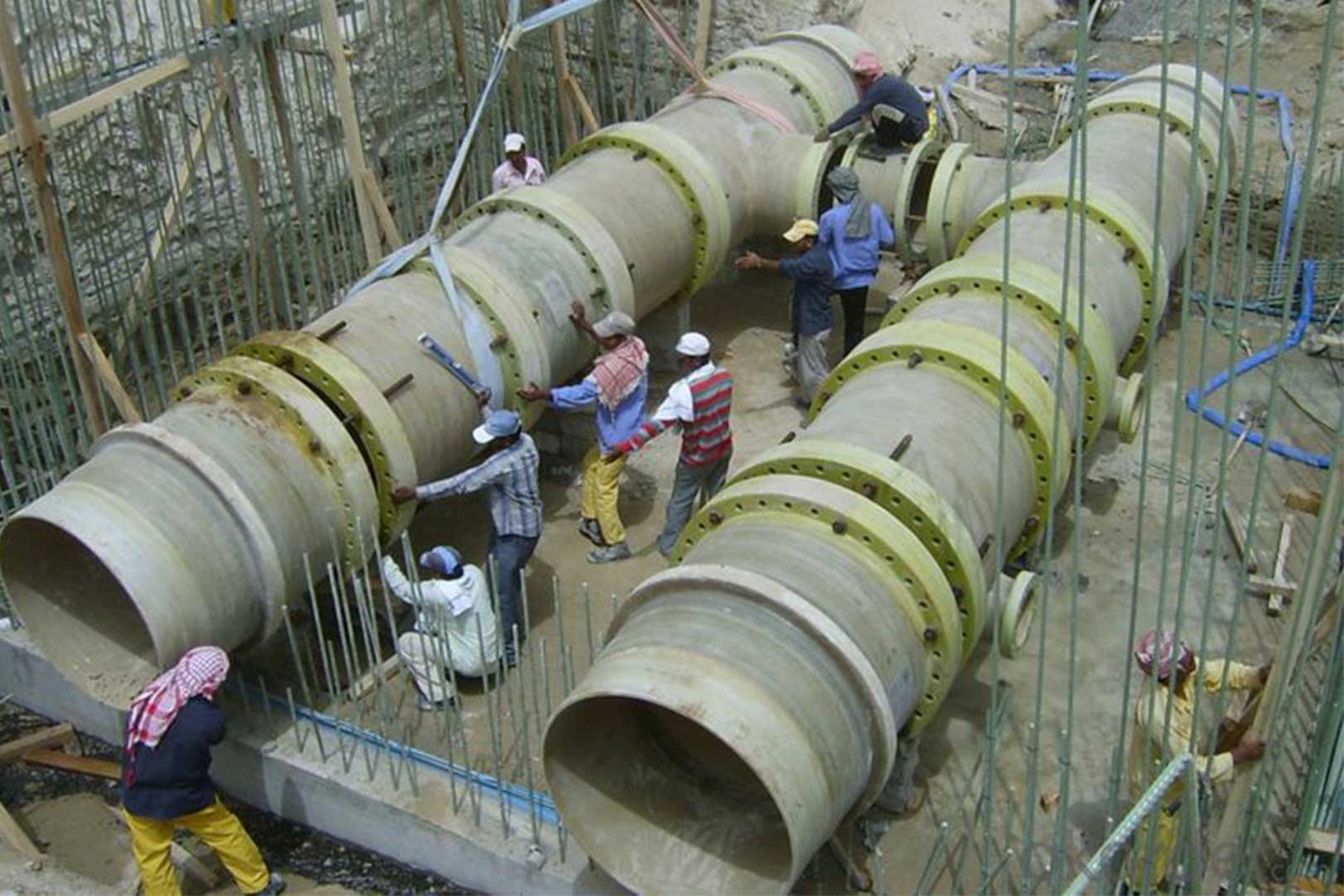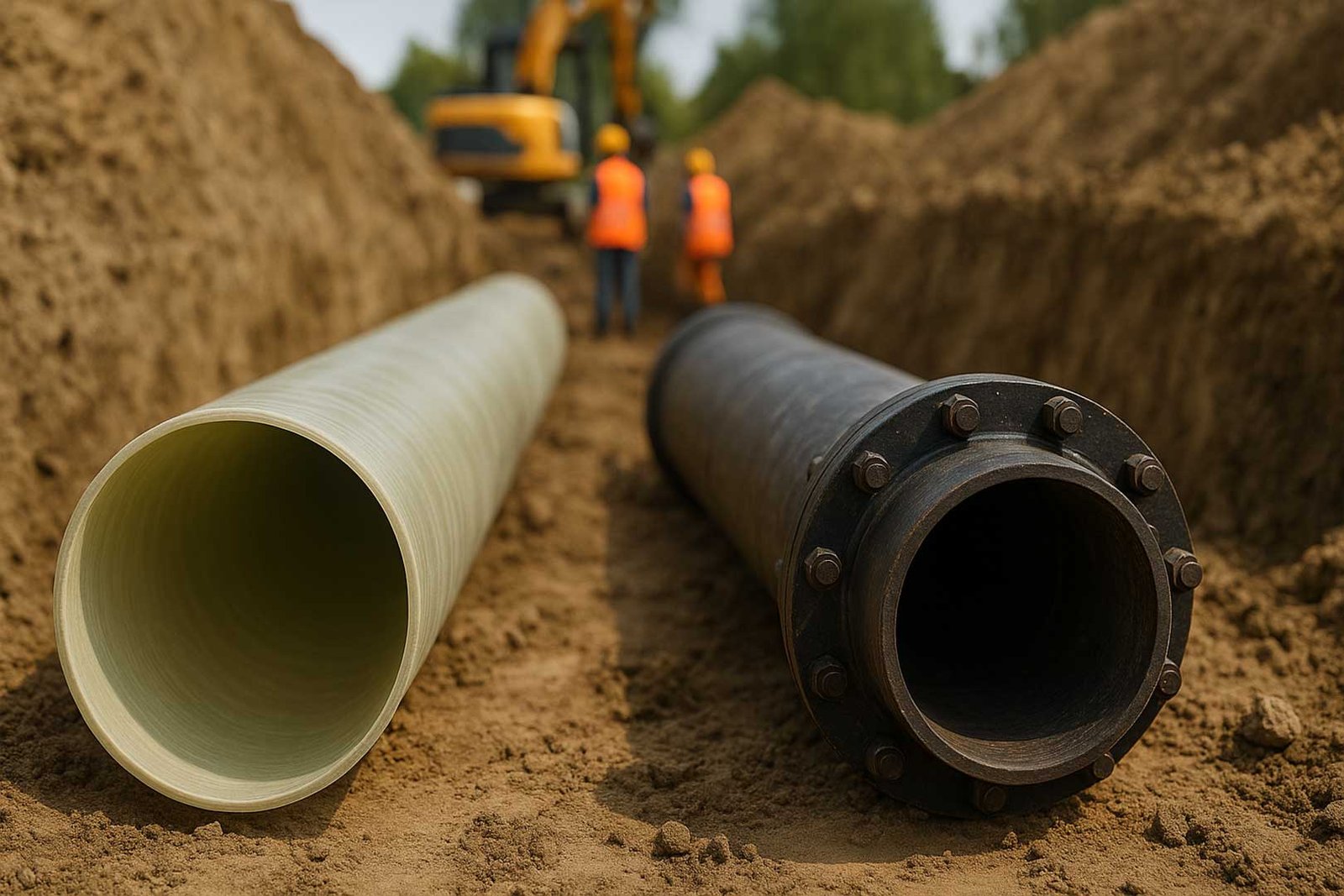
Each piping system may require a specific pipeline, including characteristics such as corrosion resistance, durability, or cost-effectiveness. The proper selection will reduce the need for maintenance while delivering a long-lasting hydraulic performance. GRP pipes are preferred due to their lightweight. In contrast, ductile iron pipes are generally used for high-pressure applications.
GRP pipe stands out in pipeline selection over ductile iron pipe for several reasons. First, its lightweight (~25% of ductile iron’s weight) and corrosion resistance reduces maintenance and crane costs. While ductile iron pipe is heavier and requires coating and lining for increased resistance, this process contributes to an increase in carbon footprint. Additionally, GRP offers up to 60% faster installation, 20% lower pumping costs, and 70% lifecycle savings. For efficient and durable systems, GRP is the strategic choice.
Whether you’re an engineer, a project manager, or an academic, this guide will provide an all-inclusive comparison of GRP and ductile iron pipe to help you select the best pipeline for your project’s demands.
At a Glance: Key Metrics for GRP and Ductile Iron Pipe
| Parameter | GRP Pipe | Ductile Iron Pipe |
|---|---|---|
| Weight | ~1/4 of steel, ~1/3 of ductile iron (e.g., 24-inch GRP: ~20 kg/m) | Heavy (e.g., 24-inch DI: ~60–80 kg/m), requires robust equipment |
| Corrosion Resistance | Inherently corrosion-proof, no coatings needed | Susceptible to corrosion, requires polyethylene encasement or cathodic protection |
| Installation Time | Up to 60% faster due to lightweight design and simple joints | Slower, stricter backfill and compaction requirements increase labor time |
| Lifespan | 50+ years, even in corrosive environments | 25–100 years, depending on soil corrosivity and maintenance |
| Roughness (C-value) | ~150, smoother surface reduces friction loss | ~130, higher friction due to cement lining |
| Hydraulic Efficiency | High, reduces pumping energy by up to 21% | Moderate, higher friction increases energy costs |
| Maintenance Cost | Minimal, no cathodic protection or corrosion inspections needed | High, requires periodic inspections and protective measures |
| Flexibility / Ground Shift | High flexibility, ideal for seismic zones and ground movement | Moderate, less adaptable to ground shifts, risk of joint failure |
Material Basics: What Are GRP and Ductile Iron Pipes?
Understanding the differences between GRP and ductile iron pipes is necessary for selecting the most appropriate piping system. Let’s dive into the manufacturing process, standards, and sustainable considerations of each.
Composition and Manufacturing Process
Glass Reinforced Plastic (GRP) pipes are crafted from layers of fiberglass in a resin matrix like polyester or vinyl ester. ScienceDirect highlights that in the filament winding method, fibers are twisted around a mold and covered by resin, while in centrifugal casting, large-diameters are made, which are ideally used for water systems or industrial transmission.
Ductile Iron (DI) pipes are manufactured from a nodular iron-carbon matrix that improves strength and durability in high-pressure systems through the centrifugal casting method. To avoid corrosion, a cement mortar lining is applied to the inner side, and external coating prevents aggressive soil damage in high-pressure piping systems.
Standards and Certifications
International standards provide consistency in piping systems. Each pipeline follows specific standards, here are several examples:
On the one hand, GRP pipes conform to ISO 10639 for water systems, EN 1796 for wastewater systems, and AWWA C950 for fiberglass pressure pipes to guarantee durability and perfect performance in various applications. (Source: Academia)
On the other hand, ductile iron pipes follow AWWA C151 for water distribution and ASTM A746 for wastewater systems. Also, ISO 2531 verifies joining and fitting in ductile iron pipes meet certain components.
Environmental Compatibility and Sustainability
Due to the lightweight and corrosion resistance of GRP pipes, they reduce the need for high fuel consumption and coating while including a 50-100-year lifespan to lower the environmental impacts.
Ductile iron pipe contains nearly 95% recycled content, suitable for a circular economy. However, its carbon footprint is higher than GRP pipe due to coating and intensively high energy requirements.
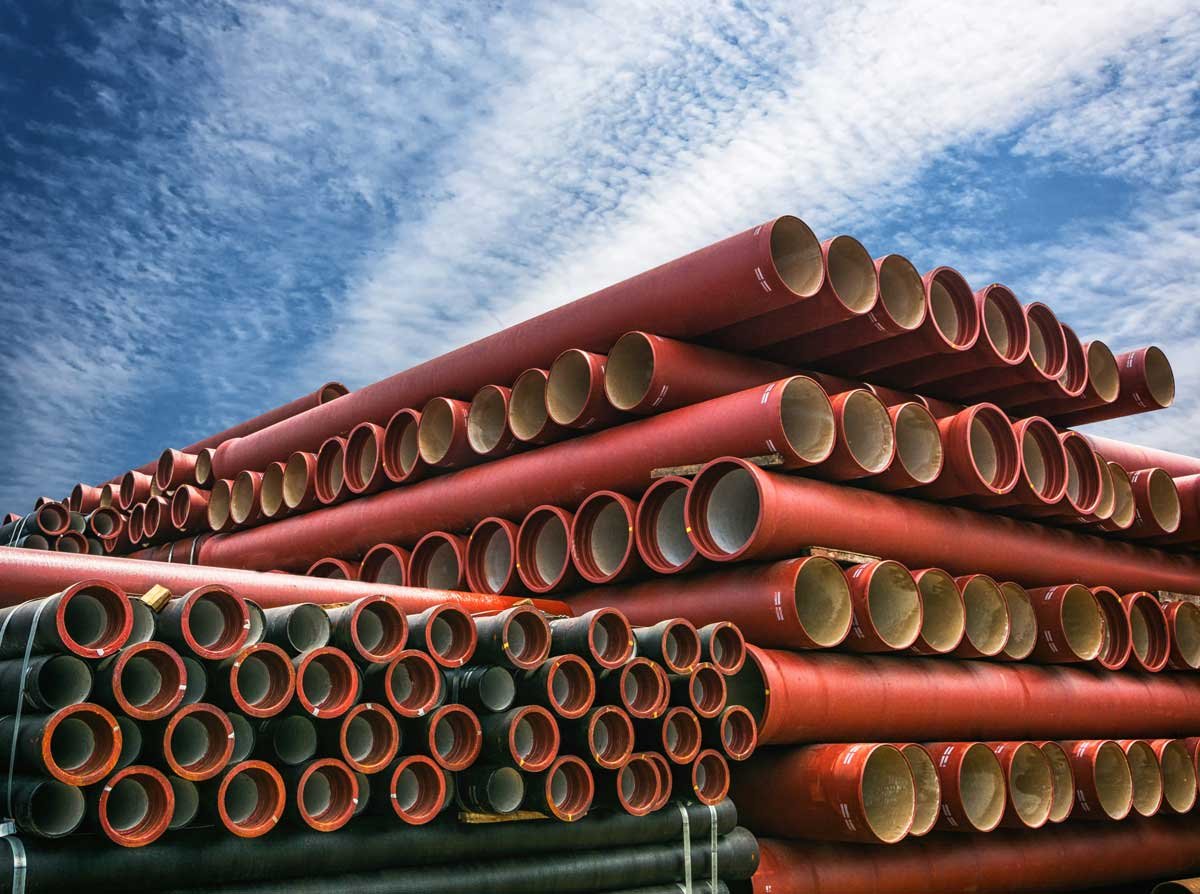
1. Mechanical & Structural Performance: GRP vs Ductile Iron Pipes
GRP and ductile iron pipe both require specific mechanical characteristics such as elongation, strength, flexibility, and surge loads.
Tensile Strength, Elongation, and Flexibility
The composite structure of GRP pipes provides a high strength-to-weight ratio (ranging from 300-375 MPa), while 2% of elongation shapes flexible behavior in seismic zones.
In contrast, ductile iron pipe contains a lower elongation (mainly <0.5%) and such a high strength that it can’t handle unstable soils and cause cracks.
Performance under Pressure: Burst Resistance and Surge Loads
Due to the composite nature of the GRP pipe, it’ll handle internal pressures up to 40 bars, though there may be some failure because of the light structure of the GRP pipe (fiber or matrix cracking). At the same time, showing such a magnificent performance under surge loads in water transmission systems.
Ductile iron pipe shines at high pressures (up to 350 psi in some classes), though it may act less efficiently in surge loads, which may require thrust blocks or robust joints.
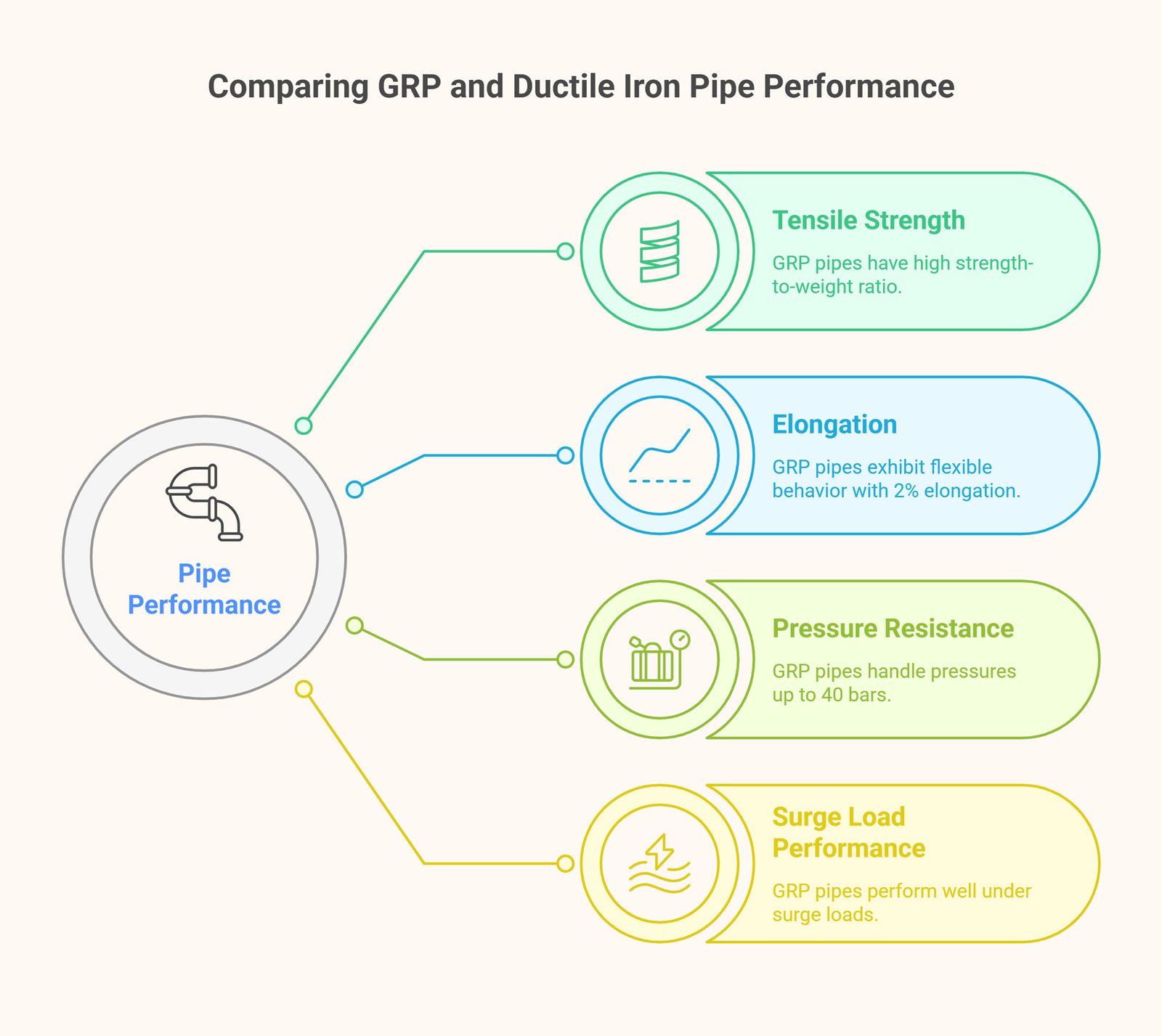
Case Comparisons from Municipal or Industrial Networks
In a municipal water system in Sydney, Australia, a ductile iron pipeline was evaluated in clay soils under water pressure, which demonstrated good performance in terms of pressure resistance. However, some corrosion was observed, and the costs for maintenance and cathodic protection were remarkably high.
Moreover, in a desalination plant in the Middle East, GRP pipes were used for seawater transportation due to their lightweight nature and corrosion resistance, with no repair requirements even after 5 years.
| Parameter | GRP Pipe | Ductile Iron Pipe |
|---|---|---|
| Tensile Strength | 300–375 MPa. High strength-to-weight ratio for high-pressure systems. | ~420 MPa. Strong but heavier, suits stable settings. |
| Elongation & Flexibility | ~2% elongation. Flexible, ideal for seismic zones. | <0.5% elongation. Rigid, may crack in unstable soils. |
| Performance under Pressure | Up to 40 bar burst resistance. Low surge (~22 psi at 2 ft/s). | Up to 350 psi burst resistance. High surge (~100 psi at 2 ft/s). |
| Modulus of Elasticity | ~20–30 GPa. Flexible in dynamic conditions. | ~170 GPa. Stiff, less adaptable to shifts. |
| Impact Resistance | Moderate, absorbs impacts. Good for buried installations. | High, resists traffic loads but corrosion-prone. |
GRP pipes offer a high strength-to-weight ratio which makes it perfect for both high-pressure and buried installations.
2. Corrosion Resistance & Environmental Durability
To build a long-lasting water infrastructure project, corrosion-free and sustainable durability will ease the process and save costs. Moreover, this matter will change the game in other industrial applications of both GRP and ductile iron pipe.
External Corrosion in Soil and Groundwater
The ductile iron pipe has demonstrated a lack of performance in terms of external corrosion resistance in aggressive soils. If the protective external coating is removed, the lifespan of the ductile iron pipe will decrease to 25-40 years.
GRP pipes are typically corrosion resistance with no coating added in aggressive soils and groundwater (e.g., high-chloride or harsh environmental conditions)
Internal Corrosion: Cement Mortar vs Resin Liners
GRP pipe uses its resin base for inner protective lining whether in acidic or soft waters with no degradation. While in ductile iron pipe, the story has changed due to the usage of cement mortar linings to prevent internal corrosion. (Source: DIPRA) However, as time goes by, in some pH ranges, ductile iron pipe faces some corrosion in aggressive waters or soils.
Resistance to Chemicals, Seawater, and Industrial Effluents
GRP pipes are perfect choices for desalination plants due to the resin matrix’s resistance in saline conditions with no degradations.
To handle the high acidity of industrial effluents, extra coatings are required in ductile iron pipes. Unlike GRP pipes, ductile iron pipes encounter intense corrosion in saline conditions.
| Parameter | GRP Pipe | Ductile Iron Pipe |
|---|---|---|
| External Corrosion | Corrosion-proof; ideal for underground pipe installation. | Prone to ductile iron pipe corrosion; needs coatings. |
| Internal Corrosion | Resin liners resist acidic/saline water; no degradation. | Cement linings degrade in low-pH water; rust risk. |
| Chemical Resistance | Resists seawater, acids; suits GRP pipe for industrial use. | Limited; needs coatings for seawater systems. |
| Lifespan in Corrosive Soils | 50–100 years; no failures from soil corrosivity impact. | 25–40 years; reduced by corrosive soils. |
| Maintenance Needs | Minimal; no coatings or inspections needed. | High; requires coatings and cathodic protection. |
| Seawater & Industrial Suitability | Ideal for seawater intake lines, chemical plants. | Poor; high maintenance in aggressive environments. |
In real-world data, ductile iron pipe lifespan is reduced in corrosive soils intensively, while GRP pipe shows a corrosion-proof performance with no coatings added!
3. Hydraulic Efficiency & Water Quality
GRP pipes have a smoother inner surface (including a C-value of 150-160),, which eases water flow compared to ductile iron pipes with cement mortar linings at 130-140. Moreover, this characteristic of the GRP pipe shows its efficiency in water transmission systems.
Pumping Energy Demand and Pumping Energy Demand
This reduction in GRP pipes’ friction affects pumping energy demand in a way that reduces about 15-20% to ductile iron pipe despite cement mortar linings, which may increase water alkalinity and pH shifts in potable water systems. While in GRP pipes, inner resin liners prevent any changes in water quality and ensure such a reliable water transmission.
| Parameter | GRP Pipe | Ductile Iron Pipe |
|---|---|---|
| Roughness Coefficient | Hazen-Williams C-value 150–160; smoother, less friction loss. Ideal for hydraulic efficiency of GRP. | C-value 120–140; higher friction loss. |
| Pumping Energy Demand | Up to 20% lower due to smoother flow; reduces energy bills. | Higher due to increased friction; raises costs. |
| Water Quality Effect | Stable pH; maintains hygiene, no alkalinity shift. | Cement linings increase alkalinity, affecting pH/taste |
As mentioned in ScienceDirect, GRP pipes with inner resin liners (whether polyester or vinylester) represent higher water hygiene and reduce energy bills.
4. Installation Efficiency & Logistics
Installation and joining methods of both GRP and ductile iron pipes are another essential part in selecting the best option for the piping system projects. Depending on pipe weight, joint type, timing, and labor cost, the choice of the desired pipeline can shift.
Pipe Weight, Transport, and Equipment Needs
GRP pipe includes a weight of approximately one-fourth of ductile iron pipe (e.g., a 600mm GRP pipe weighs ~25 kg/m compared to ~100 kg/m for ductile iron), which increases the cost of transportation, and the need for special equipment in the ductile iron pipe. Thus, the GRP pipe is an ideal choice for underground pipelines.
Joint Types and Number of Connections
GRP pipes are mainly connected via bell and spigot or coupling joints and ductile iron pipes use push-on or mechanical joints that can increase the cost and connection time while adding difficulty of further maintenance.
Installation Time and Labor Cost
Due to the lightweight and easy-to-apply joining methods of GRP pipe, the result is a faster installation than ductile iron pipe in water piping systems and aboveground pipelines where traffic requires fast installation.
| Parameter | GRP Pipe | Ductile Iron Pipe |
|---|---|---|
| Weight (600mm) | ~25 kg/m (lightweight) | ~100 kg/m (heavy) |
| Transport Needs | Lower fuel and equipment costs | Higher due to weight |
| Joint Types | Bell-and-spigot, fewer connections | Push-on/mechanical, more connections |
| Installation Time | Up to 60% faster | Slower due to weight and joint complexity |
| Labor Cost | ~25% lower | Higher due to equipment and time needs |
Compared to ductile iron pipe, GRP pipe can decrease the need for a crane and boost the speed of installation by up to 60%.
5. Lifespan, Maintenance & Reliability
The right selection of pipelines will last over decades; then, it does matter to consider the lifespan and maintenance needs for both GRP and ductile iron pipe.
Real-World Service Life
GRP pipe lasts 50-100 years in harsh environments and aggressive soils with no corrosion or degradation due to their resistance against harmful matters. At the same time, ductile iron pipes have a lifespan of 25-40 years that may be decreased in corrosive soils or harsh water environments.
Risk of Failure
In high-chloride, sulfate soils or in seismic zones, the selection of ductile iron pipe may be a failure due to inappropriate performance shown or joint damage. In contrast, GRP pipe provides a flexible design, corrosion-free, and lightweight nature that lowers the risk of failure in difficulties.
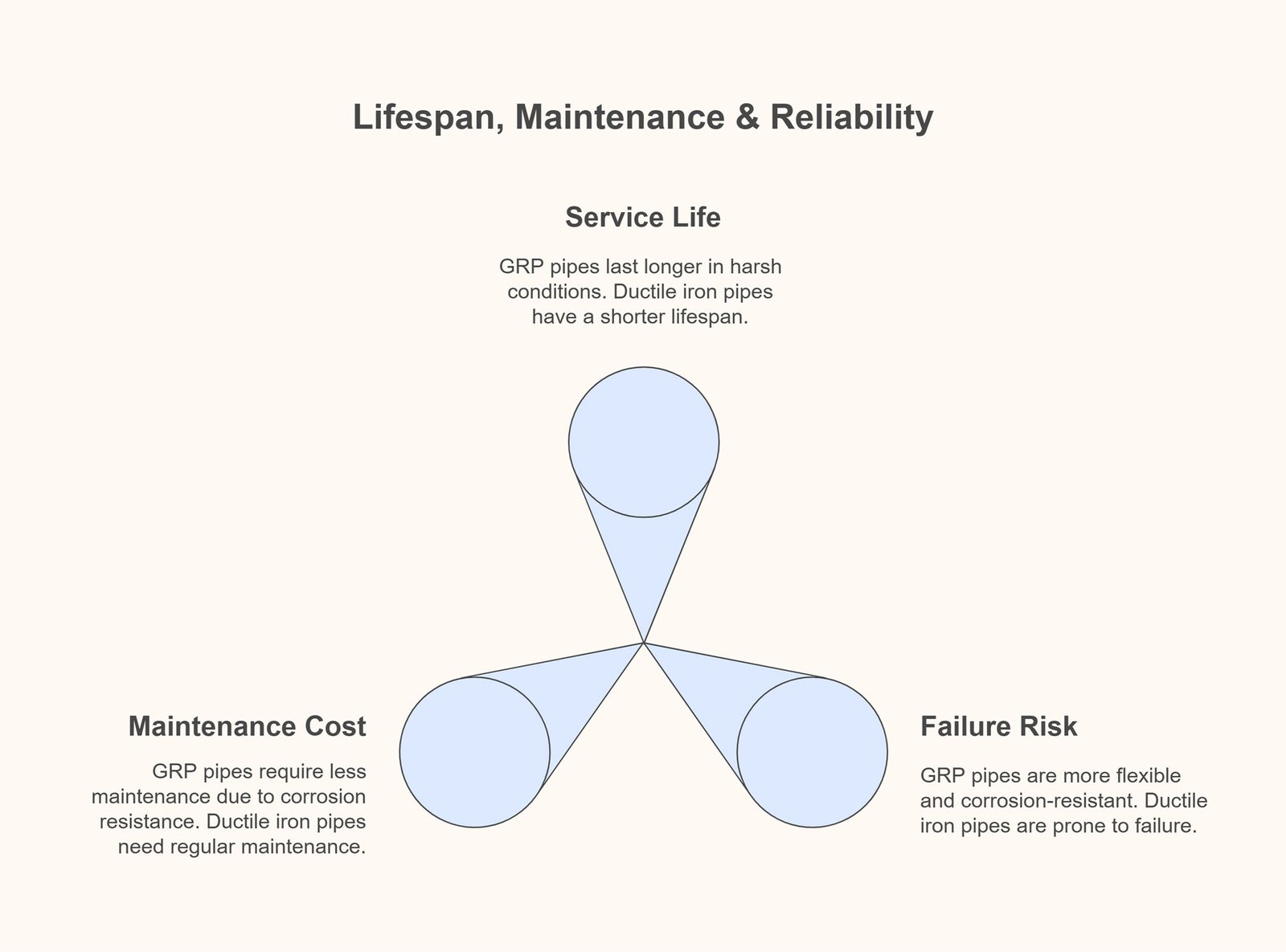
Maintenance Requirements and Cost
Ductile iron pipe requires regular maintenance or further coating and lining for corrosion resistance in harsh conditions. According to ResearchGate, ductile iron pipelines can increase costs by up to 10%.
GRP pipes include a resin nature that has no corrosion and minimizes the maintenance need for decades.
| Parameter | GRP Pipe | Ductile Iron Pipe |
|---|---|---|
| Service Life | 50–100 years | 25–40 years |
| Risk of Failure | Low (<2% joint failure) | Higher (10–15% joint/corrosion failure) |
| Maintenance Needs | Minimal (no corrosion inspections) | High (cathodic protection, linings) |
| Maintenance Cost | <1% of installation cost annually | 5–10% of installation cost annually |
Above all, GRP pipes avoid any cathodic protection, lining requirements, or corrosion inspections.
6. Cost Comparison: Initial, Operational, and Lifecycle
After all, GRP and ductile iron pipes should be compared in terms of costs and lifecycle to choose the best option at the end.
- Material Cost per Meter: GRP pipe has a lower cost than ductile iron pipe per meter (basically from $40–$80 per meter compared to $50–$100 per meter in 600mm diameter pipe). The composite nature and continued lower costs make GRP pipe such a perfect choice for piping projects.
- Installation and Trenching Costs: Due to the lightweight design of GRP pipe over the ductile iron pipe, GRP pipe minimizes the need for maintenance or heavy cranes while decreasing the cost of installation by up to 30%.
- Long-Term Operational and Replacement Costs: The longer lifespan in GRP pipe compared to ductile iron pipe (50-100 years and 25-40 years) also emphasizes on reducing around 10% of initial costs each year.
- Cost of Pump Energy: A smoother inner surface in GRP pipe decreases the cost of pumping energy (15-20%).
| Parameter | GRP Pipe | Ductile Iron Pipe |
|---|---|---|
| Material Cost (600mm) | $40–$80/m | $50–$100/m |
| Installation/Trenching Cost | Up to 30% lower (lightweight) | Higher (heavier, more equipment) |
| Operational Maintenance Cost | <1% of installation cost annually | 5–10% of installation cost annually |
| Pump Energy Cost | 15–20% lower (high hydraulic efficiency) | Higher (increased friction losses) |
| Lifecycle Cost Savings | Up to 70% in corrosive/high-flow settings | Higher due to maintenance/replacement |
Key Insight: GRP pipes offer up to 70% savings on total lifecycle costs in corrosive and high-flow environments, driven by lower material, installation, maintenance, and energy costs.
Real-World Use Cases & Application Scenarios
The ductile iron pipe still has a chance to be selected due to its strength in high-pressure systems (40 bar pressure tolerance). Also, its durability in high vandalism zones like urban areas makes it perfect to handle external loads. However, GRP pipe is superior due to several reasons explained below:
- Desalination Plants: GRP pipe has shown a magnificent performance in saline environments where Dubai’s Jebel Ali plant evaluated a notable reduction in maintenance costs by choosing GRP instead of ductile iron pipe.
- Underground Utilities in Urban Projects: The lightweight and flexibility of GRP in dynamic soils like seismic zones makes it perfect for a project in London in 2024 that decreased joint failure by up to 25% compared with a ductile iron pipe.
- Seawater Intake Lines: In Oman’s Al Ghubrah desalination plant, corrosive resistance GRP pipes guarantee corrosion-free piping systems for decades in saline conditions.
Partner with GrandPipeGroup to optimize your pipeline project with cutting-edge GRP solutions. Request a quote today!
Now, let’s check out how these two piping materials act in different applications at a glance:
| Application | GRP Pipe | Ductile Iron Pipe |
|---|---|---|
| High Vandalism Zones | Less resistant to physical damage | Preferred for durability against impacts |
| High Pressure (>40 bar) | Limited to specific designs | Preferred for extreme pressure classes |
| Seawater Intake Lines | Corrosion-free, ideal for saline conditions | Prone to corrosion, requires coatings |
| Desalination Plants | Low maintenance, chemical resistance | Higher maintenance costs |
| Long-Distance Water Transmission | High hydraulic efficiency, lower energy costs | Higher friction losses, increased costs |
| Urban Underground Utilities | Flexible, lightweight, fewer joint failures | Rigid, heavier, more joint failures |
Final Thought
To effectively aim your strategic plans for the piping systems project, several key factors should be considered. From a basic understanding of GRP and ductile iron pipe to characteristics such as mechanical performance, corrosion resistance, and hydraulic and installation efficiency, all pave the way to select the best pipeline matched to the project’s demands.
GrandPipeGroup’s consultants aid you in designing your piping project through modern GRP solutions. Contact GrandPipeGroup for technical specifications, project consultation, or RFQs.
FAQs
1- Why are GRP pipes preferred over ductile iron pipes?
GRP pipes are preferred due to their lightweight, which reduces the need for maintenance while delivering a long-lasting hydraulic performance. In contrast, ductile iron pipes are normally used for high-pressure applications.
2- What is the installation time difference between GRP and ductile iron pipes?
GRP Pipe installation is up to 60% faster due to its lightweight design and simple joints (e.g., push-fit, adhesive), ideal for trenchless installation, while Ductile Iron Pipe installation is slower and labor-intensive due to its heavy weight and mechanical joints (e.g., push-on, flanged), requiring deeper trenches.
3- How do GRP and ductile iron pipes compare in hydraulic efficiency?
GRP Pipe has a Hazen-Williams C-value ~150, with a smoother surface that reduces friction losses, and up to 20% lower pumping energy costs, ideal for water transmission, whereas Ductile Iron Pipe has a C-value ~130 (cement-lined), with higher roughness that increases friction losses and higher pumping costs.
4- What are the weight differences between GRP and ductile iron pipes, and how do they impact costs?
GRP Pipe is lightweight, ~25% of Ductile Iron (e.g., 6–20 kg/m for DN300), reducing transport and equipment costs, while Ductile Iron Pipe is heavy, ~80–100 kg/m for DN300, requiring cranes and heavy machinery for handling.
5- How long do GRP and ductile iron pipes last?
GRP Pipe lasts 50–100 years, even in corrosive environments, due to corrosion resistance, while Ductile Iron Pipe lasts 25–40 years in corrosive soils, up to 100 years in ideal conditions with maintenance.
about
The Author
Farshid Tavakoli is a seasoned professional in engineering and international trade. Holding degrees in Electrical Engineering, Mechatronics, and a Doctorate in Business Administration (DBA) from the University of Lyon, he also has a strong background in industrial automation and production line technologies.
For over 17 years, he has led an international trading company, gaining deep expertise in commercial solutions tailored to industrial needs. With more than 8 years of active involvement in infrastructure development, he specializes in the supply of electromechanical equipment for water and wastewater treatment plants and transfer projects.
Together with comapny expert team, he now provides consultancy and integrated solutions for sourcing and implementing complex infrastructure projects across the region.

